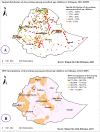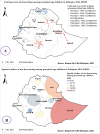Community and individual level determinants and spatial distribution of deworming among preschool age children in Ethiopia: spatial and multi-level analysis
- PMID: 35501790
- PMCID: PMC9059375
- DOI: 10.1186/s12889-022-13249-y
Community and individual level determinants and spatial distribution of deworming among preschool age children in Ethiopia: spatial and multi-level analysis
Abstract
Background: Soil-transmitted helminths caused millions of morbidity of preschool age children in sub-Saharan Africa with low socio-economic status and lack of clean water and sanitation. In Ethiopia, nearly half of children are affected by intestinal parasites. Despite this prevalence, deworming medication utilization among preschool age children is low. Hence, this study aimed to assess the community and individual level determinants and spatial distributions of deworming among preschool age children in Ethiopia.
Methods: Crossectional collected 2016 Ethiopian Demographic and Health Survey datasets with a total weighted 8146 children 12-59 months old were used for this study. The data were cleaned, extracted, and analyzed using STAT Version 16 software and exported to MS excel for spatial analysis. In addition, ArcGIS and SaTScan software were used to detect the geographic distribution of deworming utilization among preschool age children.
Results: The magnitude of deworming among preschool age children in Ethiopia was 13.32% (95% CI: 12.60, 14.08) and ranges from the lowest 3.34% (95% CI: 1.01, 10.45) Afar region to the highest 28.66% (95% CI:24.95, 32.69) Tigray region. In multilevel multivariable logistics regression analysis; variables such as secondary and above women education [AOR = 1.89; 95%CI; 1.32, 2.73], women who have occupation [AOR = 1.47; 95%CI; 1.23, 1.76], child with 12-23 months old [AOR = 2.00; 95%CI; 1.62, 2.46], having ANC visit [AOR = 1.68; 95%CI; 1.35, 2.08], households that have media exposure [AOR = 1.50; 95%CI; 1.22, 1.85] were significantly associated with deworming among preschool age children. Afar, Eastern Amhara, Dire Dewa, Harari, Somalia, and Eastern SNNPE regions were cold spot regions with Global Moran's I value 0.268 (p < 0.0001) for deworming of preschool age children.
Conclusions: The prevalence of deworming among preschool age children in Ethiopia is relatively low. Individual-level factors such as; maternal education and occupation, having ANC visit, child age, household media exposure, and community-level variables such as; community media usage had a significant association with deworming among preschool age children in Ethiopia. These findings highlight that, the Ministry of Health (MOH) Ethiopia should prepare a regular campaign for deworming programs for preschool age children. Mass media promotion of deworming should be strengthened. The Ministry of Education should work to strengthen women's education, household and community media exposure. Prior attention should be given to low deworming regions such as Afar, Somalia, Diredewa, and Harari regions.
Keywords: Deworming; Ethiopia; Preschool; Spatial.
© 2022. The Author(s).
Conflict of interest statement
The authors declare that they have no competing interests.
Figures




Similar articles
-
Deworming among preschool age children in sub-Saharan Africa: pooled prevalence and multi-level analysis.Trop Med Health. 2022 Oct 8;50(1):74. doi: 10.1186/s41182-022-00465-w. Trop Med Health. 2022. PMID: 36209125 Free PMC article.
-
Spatial distribution and determinants of bottle feeding among children 0-23 months in Ethiopia: spatial and multi-level analysis based on 2016 EDHS.BMC Pediatr. 2022 Mar 9;22(1):120. doi: 10.1186/s12887-022-03181-w. BMC Pediatr. 2022. PMID: 35264134 Free PMC article.
-
Geographic variation and associated factors of long-acting contraceptive use among reproductive-age women in Ethiopia: a multi-level and spatial analysis of Ethiopian Demographic and Health Survey 2016 data.Reprod Health. 2021 Jun 10;18(1):122. doi: 10.1186/s12978-021-01171-2. Reprod Health. 2021. PMID: 34112194 Free PMC article.
-
Spatial Distribution and Determinants of Early Marriage among Married Women in Ethiopia: A spatial and Multilevel Analysis.BMC Womens Health. 2020 Sep 15;20(1):207. doi: 10.1186/s12905-020-01070-x. BMC Womens Health. 2020. PMID: 32933491 Free PMC article.
-
Applied nutritional investigation spatial variation and determinants of stunting among children aged less than 5 y in Ethiopia: A spatial and multilevel analysis of Ethiopian Demographic and Health Survey 2019.Nutrition. 2022 Nov-Dec;103-104:111786. doi: 10.1016/j.nut.2022.111786. Epub 2022 Jul 1. Nutrition. 2022. PMID: 35970098 Review.
Cited by
-
Deworming among preschool age children in sub-Saharan Africa: pooled prevalence and multi-level analysis.Trop Med Health. 2022 Oct 8;50(1):74. doi: 10.1186/s41182-022-00465-w. Trop Med Health. 2022. PMID: 36209125 Free PMC article.
-
Spatial distribution of effective coverage of child immunisation in Ethiopia.BMJ Public Health. 2025 May 26;3(1):e002255. doi: 10.1136/bmjph-2024-002255. eCollection 2025. BMJ Public Health. 2025. PMID: 40433074 Free PMC article.
-
Epidemiological trends of hepatitis C incidence and death in Mainland China between 2004 and 2018 and its predictions to 2030.BMC Infect Dis. 2025 Apr 8;25(1):483. doi: 10.1186/s12879-025-10881-y. BMC Infect Dis. 2025. PMID: 40200162 Free PMC article.
-
Individual and community-level determinants and spatial distribution of prenatal HIV test uptake in Ethiopia: Spatial and multilevel analysis.Front Public Health. 2023 Feb 21;11:962539. doi: 10.3389/fpubh.2023.962539. eCollection 2023. Front Public Health. 2023. PMID: 36895690 Free PMC article.
-
Mapping the effective coverage of modern contraceptive services in Ethiopia.PLoS One. 2025 Jul 7;20(7):e0327581. doi: 10.1371/journal.pone.0327581. eCollection 2025. PLoS One. 2025. PMID: 40622946 Free PMC article.
References
-
- Tchuenté LT. Control of soil-transmitted helminths in sub-Saharan Africa: diagnosis, drug efficacy concerns, and challenges. Acta Trop. 2011;120:S4–S11. - PubMed
Publication types
MeSH terms
LinkOut - more resources
Full Text Sources

